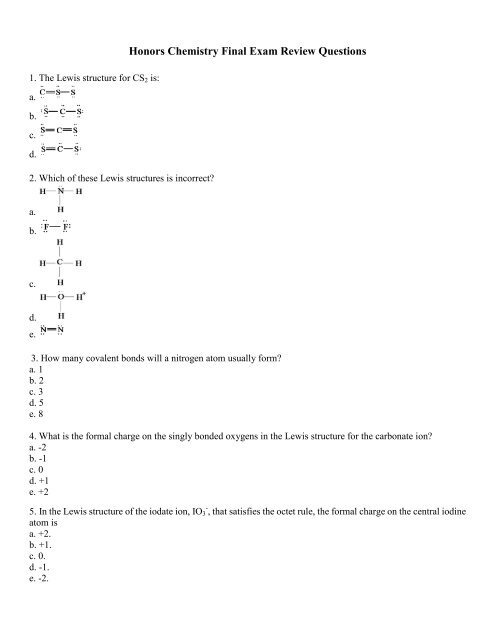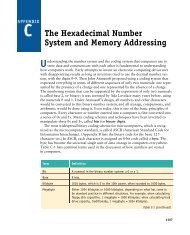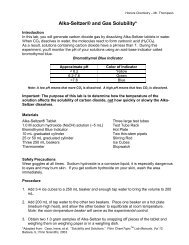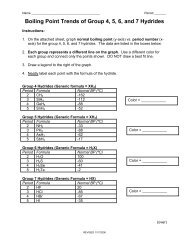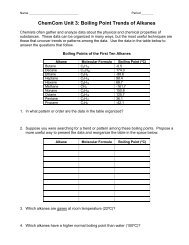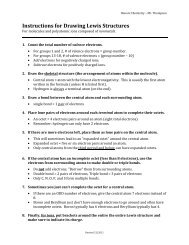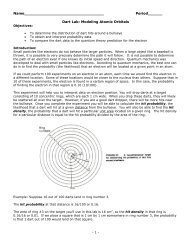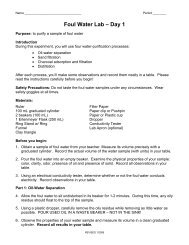Honors Chemistry Final Exam Review Questions
Honors Chemistry Final Exam Review Questions
Honors Chemistry Final Exam Review Questions
You also want an ePaper? Increase the reach of your titles
YUMPU automatically turns print PDFs into web optimized ePapers that Google loves.
1. The Lewis structure for CS2 is:<br />
a.<br />
b.<br />
c.<br />
d.<br />
2. Which of these Lewis structures is incorrect?<br />
a.<br />
b.<br />
c.<br />
d.<br />
e.<br />
<strong>Honors</strong> <strong>Chemistry</strong> <strong>Final</strong> <strong>Exam</strong> <strong>Review</strong> <strong>Questions</strong><br />
3. How many covalent bonds will a nitrogen atom usually form?<br />
a. 1<br />
b. 2<br />
c. 3<br />
d. 5<br />
e. 8<br />
4. What is the formal charge on the singly bonded oxygens in the Lewis structure for the carbonate ion?<br />
a. -2<br />
b. -1<br />
c. 0<br />
d. +1<br />
e. +2<br />
5. In the Lewis structure of the iodate ion, IO3 - , that satisfies the octet rule, the formal charge on the central iodine<br />
atom is<br />
a. +2.<br />
b. +1.<br />
c. 0.<br />
d. -1.<br />
e. -2.
6. Which of these substances will display an incomplete octet in its Lewis structure?<br />
a. CO2<br />
b. Cl2<br />
c. ICl<br />
d. NO<br />
e. SO2<br />
7. According to VSEPR theory, the shape of the PH3 molecule is best described as<br />
a. linear.<br />
b. trigonal planar.<br />
c. tetrahedral.<br />
d. bent.<br />
e. trigonal pyramidal.<br />
8. The shape of the ClF3 molecule is best described as<br />
a. distorted tetrahedron.<br />
b. trigonal planar.<br />
c. tetrahedral.<br />
d. T-shaped.<br />
e. trigonal pyramidal.<br />
9. According to the VSEPR theory, which one of the following species should be linear?<br />
a. H2S<br />
b. HCN<br />
c. BF3<br />
d. H2CO<br />
e. SO2<br />
10. Which one of the following molecules has tetrahedral geometry?<br />
a. XeF4<br />
b. BF3<br />
c. AsF5<br />
d. CF4<br />
e. NH3<br />
11. The F-S-F bond angles in SF6 are<br />
a. 90° and 180°.<br />
b. 109.5°.<br />
c. 120°.<br />
d. 180°.<br />
e. 90° and 120°.<br />
12. Which one of the following molecules is polar?<br />
a. PBr5<br />
b. CCl4<br />
c. BrF5<br />
d. XeF2<br />
e. XeF4
13. Predict the geometry and polarity of the CS2 molecule.<br />
a. linear, polar<br />
b. linear, nonpolar<br />
c. tetrahedral, nonpolar<br />
d. bent, nonpolar<br />
e. bent, polar<br />
14. Indicate the type of hybrid orbitals used by the central atom in PCl3.<br />
a. sp<br />
b. sp 2<br />
c. sp 3<br />
d. sp 3 d<br />
e. sp 3 d 2<br />
15. Indicate the type of hybrid orbitals used by the central atom in SF6.<br />
a. sp<br />
b. sp 2<br />
c. sp 3<br />
d. sp 3 d<br />
e. sp 3 d 2<br />
16. An exothermic reaction causes the surroundings to<br />
a. warm up.<br />
b. become acidic.<br />
c. expand.<br />
d. decrease its temperature.<br />
e. release CO2.<br />
17. Calculate the amount of heat necessary to raise the temperature of 12.0 g of water from 15.4°C to 93.0°C. The<br />
specific heat of water = 4.18 J/g·°C.<br />
a. 0.027 J<br />
b. 324 J<br />
c. 389 J<br />
d. 931 J<br />
e. 3,890 J<br />
18. How many degrees of temperature rise will occur when a 25.0 g block of aluminum absorbs 10.0 kJ of heat?<br />
The specific heat of Al is 0.900 J/g·°C.<br />
a. 0.44°C<br />
b. 22.5°C<br />
c. 225°C<br />
d. 360°C<br />
e. 444°C
19. When 0.7521 g of benzoic acid was burned in a calorimeter containing 1,000. g of water, a temperature rise of<br />
3.60°C was observed. What is the heat capacity of the bomb calorimeter, excluding the water? The heat of<br />
combustion of benzoic acid is -26.42 kJ/g.<br />
a. 15.87 kJ/°C<br />
b. 4.18 kJ/°C<br />
c. 5.52 kJ/°C<br />
d. 1.34 kJ/°C<br />
e. 752.1 kJ/°C<br />
20. Which of these processes is endothermic?<br />
a. O2(g) + 2H2(g) → 2H2O(g)<br />
b. H2O(g) → H2O(l)<br />
c. 3O2(g) + 2CH3OH(g) → 2CO2(g) + 2H2O(g)<br />
d. H2O(s) → H2O(l)<br />
21. A 0.1326 g sample of magnesium was burned in an oxygen bomb calorimeter. The total heat capacity of the<br />
calorimeter plus water was 5,760 J/°C. If the temperature rise of the calorimeter with water was 0.570°C,<br />
calculate the enthalpy of combustion of magnesium.<br />
Mg(s) + 1/2O2(g) → MgO(s)<br />
a. -3280 kJ/mol<br />
b. -24.8 kJ/mol<br />
c. 435 kJ/mol<br />
d. 106 kJ/mol<br />
e. -602 kJ/mol<br />
22. The combustion of butane produces heat according to the equation<br />
2C4H10(g) + 13O2(g) → 8CO2(g) + 10H2O(l) ΔH= -5314 kJ/mol<br />
What is the heat of combustion per gram of butane?<br />
a. -32.5 kJ/g<br />
b. -45.7 kJ/g<br />
c. -91.5 kJ/g<br />
d. -2,656 kJ/g<br />
e. -15,440 kJ/g<br />
23. The combustion of butane produces heat according to the equation<br />
2C4H10(g) + 13O2(g) → 8CO2(g) + 10H2O(l) ΔH = -5,314 kJ<br />
How many grams of butane must be burned to release 6,375 kJ of heat?<br />
a. 1.20 g<br />
b. 139 g<br />
c. 0.0413 g<br />
d. 69.7 g<br />
e. 97.8 g
24. Determine the heat given off to the surroundings when 9.0 g of aluminum reacts according to the equation<br />
2Al + Fe2O3 → Al2O3 + 2Fe ΔH = -849 kJ/mol.<br />
a. 7.6 × 10 3 kJ<br />
b. 2.8 × 10 2 kJ<br />
c. 1.4 × 10 2 kJ<br />
d. 5.6 × 10 2 kJ<br />
e. 2.5 × 10 3 kJ<br />
25. 10.1 g CaO is dropped into a styrofoam coffee cup containing 157 g H2O at 18.0°C. If the following reaction<br />
occurs, then what temperature will the water reach, assuming that the cup is a perfect insulator and that the cup<br />
absorbs only a negligible amount of heat? [specific heat of water = 4.18 J/g·°C]<br />
CaO(s) + H2O(l) → Ca(OH)2(s) ΔH = -64.8 kJ/mol<br />
a. 18.02°C<br />
b. 35.8°C<br />
c. 311°C<br />
d. 42.2°C<br />
e. 117°C<br />
26. Calculate the standard enthalpy change for the reaction<br />
2C8H18(l) + 17O2(g) → 16CO(g) + 18H2O(l).<br />
a. 10,450 kJ/mol<br />
b. 6,492 kJ/mol<br />
c. 15,550 kJ/mol<br />
d. -6,492 kJ/mol<br />
e. -10.450 kJ/mol<br />
27. Given 2Al(s) + (3/2)O2(g) → Al2O3(s), = -1,670 kJ/mol for Al2O3 (s).<br />
Determine ΔH° for the reaction 2Al2O3(s) → 4Al(s) + 3O2(g).<br />
a. 3,340 kJ/mol<br />
b. 1,670 kJ/mol<br />
c. -3,340 kJ/mol<br />
d. -1,670 kJ/mol<br />
e. -835 kJ/mol<br />
28. Styrene, C8H8, is one of the substances used in the production of synthetic rubber. When styrene burns in<br />
oxygen to form carbon dioxide and liquid water under standard-state conditions at 25°C, 42.62 kJ are released per<br />
gram of styrene. Find the standard enthalpy of formation of styrene at 25°C.<br />
(Given: [CO2(g)] = -393.5 kJ/mol, [H2O(l)] = -285.8 kJ/mol, [H2O(g)] = -241.8 kJ/mol)<br />
a. 324 kJ/mol<br />
b. -4249 kJ/mol<br />
c. -8730 kJ/mol<br />
d. -637 kJ/mol<br />
e. 146 kJ/mol
29. Which one of the following substances should exhibit hydrogen bonding in the liquid state?<br />
a. PH3<br />
b. H2<br />
c. H2S<br />
d. CH4<br />
e. NH3<br />
30. <strong>Exam</strong>ine the phase diagram for the substance Bogusium (Bo) and select the correct statement.<br />
a. Bo(s) has a lower density than Bo(l).<br />
b. The triple point for Bo is at a higher temperature than the melting point for Bo.<br />
c. Bo changes from a solid to a liquid as one follows the line from C to D.<br />
d. Bo changes from a liquid to a gas as one follows the line from C to D.<br />
e. Point B represents the critical temperature and pressure for Bo.<br />
31. <strong>Exam</strong>ine the following phase diagram and determine what phase exists at point F.<br />
a. vapor + liquid<br />
b. vapor<br />
c. liquid<br />
d. solid<br />
e. supercritical fluid
32. <strong>Exam</strong>ine the following phase diagram and identify the feature represented by point B.<br />
a. melting point<br />
b. triple point<br />
c. critical point<br />
d. sublimation point<br />
e. boiling point<br />
33. Which of the following substances should have the highest boiling point?<br />
a. CH4<br />
b. Cl2<br />
c. Kr<br />
d. CH3Cl<br />
e. N2<br />
34. For which of the following species are the dispersion forces strongest?<br />
a. C4H10<br />
b. C5H12<br />
c. C6H14<br />
d. C7H16<br />
e. C8H18<br />
35. Arrange the following in order of increasing boiling point: RbCl, CH3Cl, CH3OH, CH4.<br />
a. CH3OH < CH3Cl < RbCl < CH4<br />
b. CH3OH < CH4 < CH3Cl < RbCl<br />
c. RbCl < CH3Cl < CH3OH < CH4<br />
d. CH4 < CH3OH < CH3Cl < RbCl<br />
e. CH4 < CH3Cl < CH3OH < RbCl<br />
36. Which of the following is not true with regard to water?<br />
a. Water has a high heat capacity.<br />
b. Water has an unusually high boiling point.<br />
c. Water can form hydrogen bonds.<br />
d. Ice is more dense than liquid water.<br />
e. Water is a polar molecule.<br />
37. A liquid boils when its<br />
a. vapor pressure is exactly 1 atmosphere.<br />
b. vapor pressure is equal to, or greater than, the external pressure pushing on it.<br />
c. temperature is equal to 273 K (standard temperature).<br />
d. temperature is greater than room temperature.
38. Use the graph of vapor pressure to determine the normal boiling point of CHCl3.<br />
a. 19°C<br />
b. 52°C<br />
c. 60°C<br />
d. 64°C<br />
e. 70°C<br />
39. The equilibrium constant expression for the reaction 2BrF5(g) Br2(g) + 5F2(g) is<br />
a. Kc =[Br2] [F2]/[BrF5]<br />
b. Kc = [Br2] [F2] 5 /[BrF5] 2<br />
c. Kc = [Br2] [F2] 2/ [BrF5] 5<br />
d. Kc = [BrF5] 2 /[Br2][F2] 5<br />
e. Kc = 2[BrF5] 2 /([Br2] × 5[F2] 5 )<br />
40. Calculate Kc for the reaction 2HI(g) H2(g) + I2(g) given that the concentrations of each species at<br />
equilibrium are as follows:<br />
[HI] = 0.85 mol/L, [I2] = 0.60 mol/L, [H2] = 0.27 mol/L.<br />
a. 5.25<br />
b. 0.22<br />
c. 4.5<br />
d. 0.19<br />
e. 1.6 × 10 2<br />
41. Consider the reaction N2(g) + O2(g) 2NO(g), for which Kc = 0.10 at 2,000ºC. Starting with initial<br />
concentrations of 0.040 M of N2 and 0.040 M of O2, determine the equilibrium concentration of NO.<br />
a. 5.4 × 10 -3 M<br />
b. 0.0096 M<br />
c. 0.011 M<br />
d. 0.080 M<br />
e. 0.10 M
42. For the following reaction at equilibrium, which choice gives a change that will shift the position of<br />
equilibrium to favor formation of more products?<br />
2NOBr(g) 2NO(g) + Br2(g), ΔHºrxn = 30 kJ/mol<br />
a. Increase the total pressure by decreasing the volume.<br />
b. Add more NO.<br />
c. Remove Br2.<br />
d. Lower the temperature.<br />
e. Remove NOBr selectively.<br />
43. For the following reaction at equilibrium in a reaction vessel, which one of these changes would cause the<br />
Br2 concentration to decrease?<br />
2NOBr(g) 2NO(g) + Br2(g), ΔHºrxn= 30 kJ/mol<br />
a. Increase the temperature.<br />
b. Remove some NO.<br />
c. Add more NOBr.<br />
d. Compress the gas mixture into a smaller volume.<br />
44. For the equilibrium reaction 2SO2(g) + O2(g) 2SO3(g), ΔHºrxn = -198 kJ/mol. Which one of these factors<br />
would cause the equilibrium constant to increase?<br />
a. Decrease the temperature.<br />
b. Add SO2 gas.<br />
c. Remove O2 gas.<br />
d. Add a catalyst.<br />
e. none of these<br />
45. For the reaction at equilibrium 2SO3 2SO2 + O2 (ΔHºrxn= 198 kJ/mol), if we increase the reaction<br />
temperature, the equilibrium will<br />
a. shift to the right.<br />
b. shift to the left.<br />
c. not shift.<br />
d. The question cannot be answered because the equilibrium constant is not given.<br />
46. Identify the conjugate base of HSO4 - in the reaction<br />
H2PO4 - + HSO4 - H3PO4 + SO4 2-<br />
a. H2PO4 -<br />
b. H2SO4<br />
c. H2O<br />
d. H3PO4<br />
e. SO4 2-<br />
47. Identify the conjugate acid of SO4 2- in the reaction<br />
CO3 2- + HSO4 - HCO3 - + SO4 2-<br />
a. CO3 2-<br />
b. HSO4 -<br />
c. OH -<br />
d. H3O +<br />
e. SO4 2-
48. What is the concentration of H + in a 2.5 M HCl solution?<br />
a. 0<br />
b. 1.3 M<br />
c. 2.5 M<br />
d. 5.0 M<br />
e. 10 .M<br />
49. What is the OH - ion concentration in a 5.2 × 10 -4 M HNO3 solution?<br />
a. 1.9 × 10 -11 M<br />
b. 1.0 × 10 -7 M<br />
c. 5.2 × 10 -4 M<br />
d. zero<br />
e. 1.0 × 10 -4 M<br />
50. The OH - concentration in a 7.5 × 10 -3 M Ca(OH)2 solution is<br />
a. 7.5 × 10 -3 M.<br />
b. 1.5 × 10 -2 M.<br />
c. 1.3 × 10 -12 M.<br />
d. 1.0 × 10 -7 M.<br />
e. 1.0 × 10 -14 M.<br />
51. Calculate the pH of a 3.5 × 10 -3 M HNO3 solution.<br />
a. -2.46<br />
b. 0.54<br />
c. 2.46<br />
d. 3.00<br />
e. 3.46<br />
52. Calculate the pH of a 0.14 M HNO2 solution that is 5.7% ionized.<br />
a. 0.85<br />
b. 1.70<br />
c. 2.10<br />
d. 11.90<br />
e. 13.10<br />
53. Calculate the pH of 2.6 × 10 -2 M KOH.<br />
a. 12.41<br />
b. 15.59<br />
c. 2.06<br />
d. 7.00<br />
e. 1.59<br />
54. Calculate the hydrogen ion concentration in a solution of fruit juice having a pH of 4.25.<br />
a. 1.0 × 10 -14 M<br />
b. 5.6 × 10 -5 M<br />
c. 4.0 × 10 -25 M<br />
d. 2.5 × 10 -4 M<br />
e. 5.6 × 10 -4 M
55. The pH of coffee is approximately 5.0. How many times greater is the [H3O + ] in coffee than in tap water<br />
having a pH of 8.0?<br />
a. 0.62<br />
b. 1.6<br />
c. 30<br />
d. 1,000<br />
e. 1.0 × 10 4<br />
56. Which solution will have the lowest pH?<br />
a. 0.10 M HCN<br />
b. 0.10 M HNO3<br />
c. 0.10 M NaCl<br />
d. 0.10 M H2CO3<br />
e. 0.10 M NaOH<br />
57. Acid strength decreases in the series HI > HSO4 - > HF > HCN. Which of these anions is the weakest base?<br />
a. I -<br />
b. SO4 2-<br />
c. F -<br />
d. CN -<br />
58. Hard water deposits (calcium carbonate) have built up around your bathroom sink. Which one of these<br />
substances would be most effective in dissolving the deposits?<br />
a. ammonia<br />
b. bleach (sodium hypochlorite)<br />
c. lye (sodium hydroxide)<br />
d. vinegar (acetic acid)<br />
59. Find the pH of a 0.183 M aqueous solution of hypobromous acid (HOBr), for which Ka = 2.06 × 10 -9 .<br />
a. 4.72<br />
b. 8.69<br />
c. 3.97<br />
d. 4.34<br />
e. 9.28<br />
60. Which one of these salts will form a basic solution on dissolving in water?<br />
a. NaCl<br />
b. KCN<br />
c. NaNO3<br />
d. NH4NO3<br />
e. FeCl3<br />
61. An aqueous solution of KCl would be<br />
a. neutral.<br />
b. basic.<br />
c. acidic.
62. Which one of these salts will form a basic solution upon dissolving in water?<br />
a. NaI<br />
b. NaF<br />
c. NH4NO3<br />
d. LiBr<br />
e. Cr(NO3)3<br />
63. Which one of the following salts will form an acidic solution on dissolving in water?<br />
a. LiBr<br />
b. NaF<br />
c. KOH<br />
d. FeCl3<br />
e. NaCN<br />
64. Which one of the following is a buffer solution?<br />
a. 0.40 M HCN and 0.10 KCN<br />
b. 0.20 M CH3COOH<br />
c. 1.0 M HNO3 and 1.0 M NaNO3<br />
d. 0.10 M KCN<br />
e. 0.50 M HCl and 0.10 NaCl<br />
65. Calculate the pH of a solution that is 0.410 M in HOCl and 0.050 M in NaOCl. [Ka(HOCl) = 3.2 × 10 -8 ]<br />
a. 0.39<br />
b. 3.94<br />
c. 6.58<br />
d. 7.49<br />
e. 8.40
1. C<br />
2. E<br />
3. C<br />
4. B<br />
5. A<br />
6. D<br />
7. E<br />
8. D<br />
9. B<br />
10. D<br />
11. A<br />
12. C<br />
13. B<br />
14. C<br />
15. E<br />
16. A<br />
17. E<br />
18. E<br />
19. D<br />
20. D<br />
21. E<br />
22. B<br />
23. B<br />
24. C<br />
25. B<br />
26. D<br />
27. A<br />
28. E<br />
29. E<br />
30. E<br />
31. B<br />
32. C<br />
33. D<br />
ANSWER KEY<br />
34. E<br />
35. E<br />
36. D<br />
37. B<br />
38. D<br />
39. B<br />
40. B<br />
41. C<br />
42. C<br />
43. D<br />
44. A<br />
45. A<br />
46. E<br />
47. B<br />
48. C<br />
49. A<br />
50. B<br />
51. C<br />
52. C<br />
53. A<br />
54. B<br />
55. D<br />
56. B<br />
57. A<br />
58. D<br />
59. A<br />
60. B<br />
61. A<br />
62. B<br />
63. D<br />
64. A<br />
65. C


